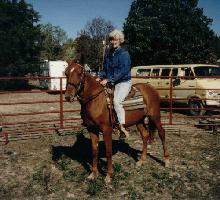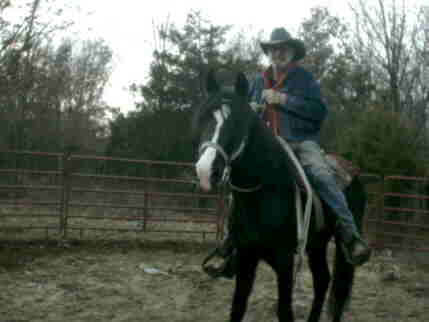
Bob Blackwell is one of the few remaining cowboys, having
been a real working cowboy along side of Billy Bishop whose influence on
horsemanship and training can be seen in the training methods being used
by today's most popular clinicians. At our farm training first begins with
imprinting when first born and continues daily with the young foal working
up to the first experience in the round pen.
At first the foal is taught simple lessons while with
its mother. For example, touching the foal and teaching the foal
to accept being touched is a good start. It is important to be able
to handle your foal for many reasons. One never knows when and at
what age medical attention may be needed. Teaching the foal at a
young age to move out of your space is more beneficial and lasting than
waiting to teach this until the foal is older and larger, picking up the
baby's feet will accustom it to what to expect later in life and to accept
it when it does, and the list goes on...Training as a baby should be controlled
and consistent. Not sporadic, or in places where you are not in control,
or in an inconsistent fashion.
The round pen is highly beneficial as a training aid
providing a controlled situation necessary if lasting and early lessons
in trust and respect are to be achieved in a supportive and humane fashion.
It is probably the easiest and safest aid for a beginner to use. The first
lessons in the round pen are not and should not be concerning gait, but
should be for teaching your horse the lessons necessary for rider safety
when it comes time for your horse to be ridden. Even though some horses
may not perform the preferred gait at first in a round pen, once they relax
and are comfortable with this setting they usually fall into the beautiful
natural gait of their namesake if they are bred right.




The in-saddle experience must also be taken slowly and in stages. I am not really an experienced rider, myself, but I have been the first to ride 2 of our young horses without a problem, a misstep, or mishap from either.



Shown here is some work in the saddle with a young horse at
one of the training clinics Bob has taught.
Other lessons might include
placing a tarp to flap in the breeze near the round pen, or have
someone walk by while
opening an umbrella, etc.,. so that these everyday distractions
are accepted by the horse as being ordinary and not a cause
to be afraid or "spook."
Eventually the horse will be taken
out of the round pen to ride on a trail. Along the path we have sacks
tied to trees, white buckets lurking in the bushes, our neighbor's emus
and ostriches, and the natural distractions of wild turkeys, deer, etc.
They
are also introduced to our neighbors cows and donkeys, farm equipment,
riding lawn mowers, etc. All is done slowly and
gradually allowing the horse to gain and maintain confidence.
There is no quick fix that is a safe
and lasting fix. Training should never be rushed and should be done in
such a manner as to create a loving bond and respect between the horse
and trainer.
Bob conducts riding, problem solving,
and shoeing clinics across the country, and gives private riding
lessons for properly riding gaited horses for the appropriate gait.
Copyright © 1997. Revised 1999 and 2000 Charlotte
Blackwell. All rights reserved.
| Back to HOSSLOGIC |
| ARTICLES INDEX |
| Blackwell Farm (foxtrotter only site) |
| Back to Blackwell Family Home |